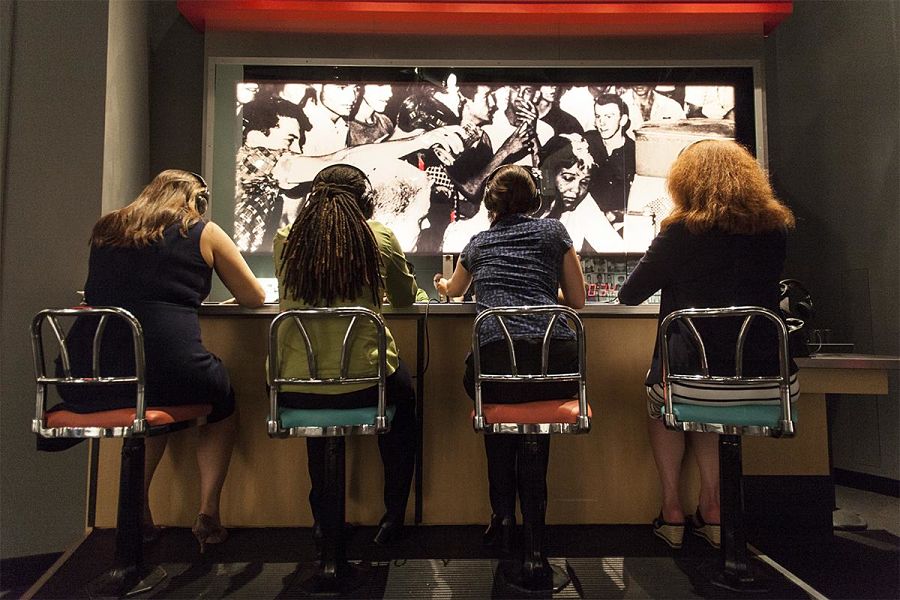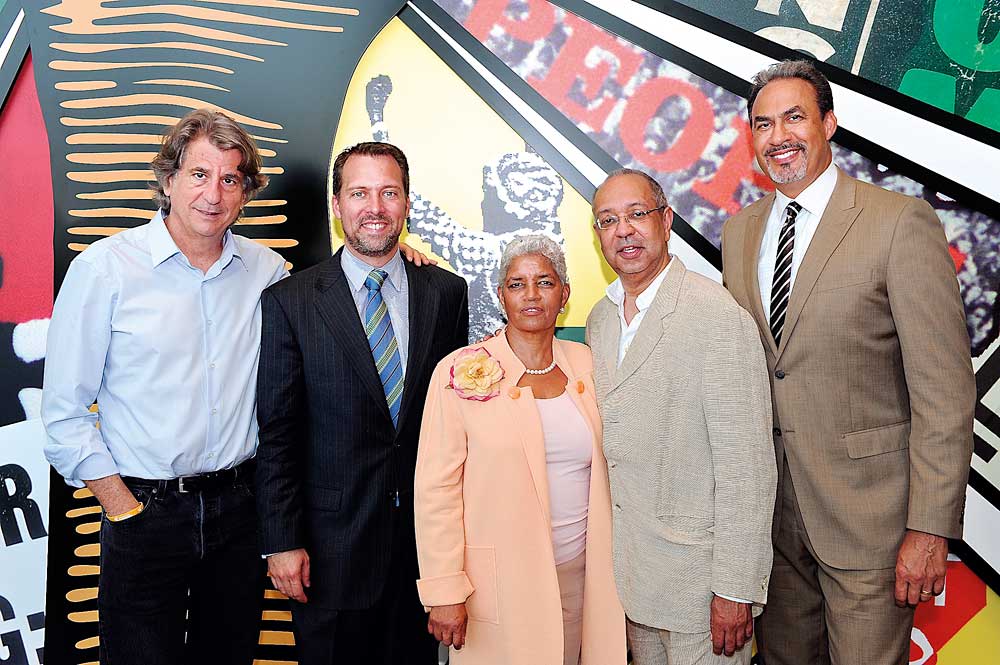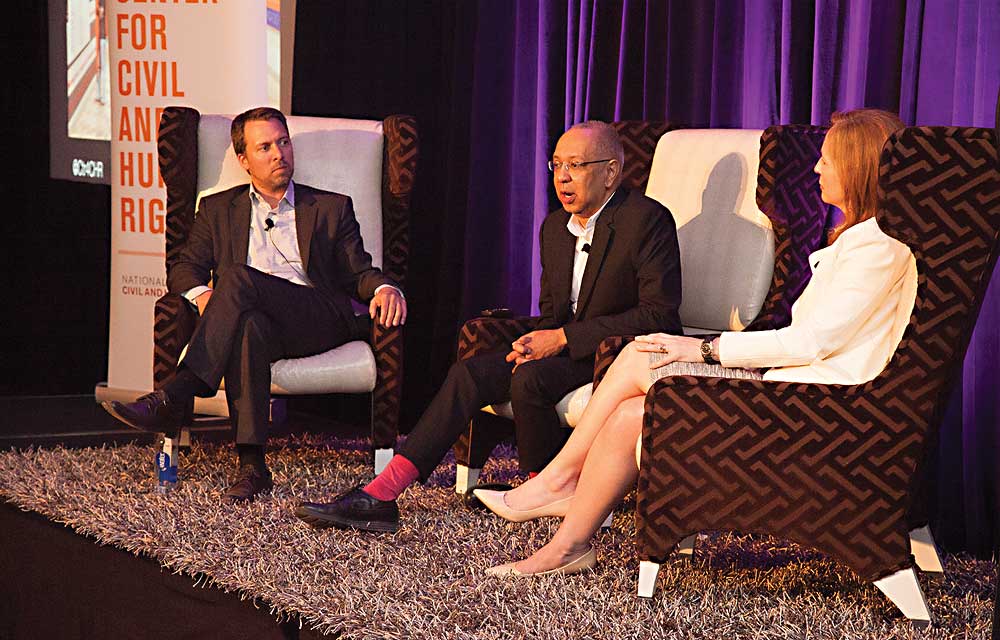“If I didn’t do theatre, I would be a historian,” George C. Wolfe confesses over a cup of tea on an unseasonably cool late August afternoon in Atlanta, Ga. The Tony-winning theatre director and playwright is wearing a sweater with shorts and speaking at breakneck speed, causing his sentences to crash into each other on their way to forming big ideas.
Wolfe envisioned one of his earliest plays, The Colored Museum—a satirical survey of African-American identity and culture—as a series of exhibits an audience would travel through. While the concept ended up being scratched for practical reasons, nearly three decades later, Wolfe finds himself the unlikely curator of an actual exhibit, “Rolls Down Like Water,” detailing the struggles of the American Civil Rights Movement from 1954 to 1968 at the newly opened Center for Civil and Human Rights, a wedge-like three-story building flanked by a massive wall of windows in downtown Atlanta.
Four years ago, Wolfe received a call from Andrea Bernstein, who served on the board of New York City’s Public Theater when he was that company’s artistic director. Bernstein connected Wolfe with Shirley Franklin, Atlanta’s mayor at the time, who was a leading proponent of the new center and served as the head of its board.
When Franklin proposed that Wolfe create one of the center’s four primary exhibitions, he was intrigued and instantly began research. “It was the same process as when I do a play,” he allows. “If it’s set in another period, I absorb as much information as I possibly can. I read as many books and try to put the period in my body as much as I possibly can, so there’s no distance between me and it, so it feels like it’s happening with some immediacy as opposed to through the lens of history.”
Wolfe, who holds the title of chief creative officer for the center, is particularly fascinated by what he calls a “living newspaper phenomenon, using the visceral intimacy of theatre, the intellectual rigor of a museum, and the intimacy of a documentary.” He traces this style of working back to the creation of his hit shows Bring in ’da Noise, Bring in ’da Funk and Harlem Song, and more specifically to the idea of seeing history through the eyes of the people who made it, an impulse that goes back to his childhood. “There was a very specific moment I remember in third grade—my mother, who was a teacher and a principal, read a chapter of my history book to me. It was about the Pilgrims and the mosquitoes and them getting sick, and, you know, killing Native American people, which was left out of most books at the time. It changed history for me. I was like, ‘Oh, this happened to people—fragile, interesting, complicated people.’”
People, to be more specific, like Viola Liuzzo, a housewife from Detroit who became a Freedom Rider, and Claudette Colvin, who preceded Rosa Parks in refusing to give up her seat on a bus. Figures like these drove Wolfe’s research and insisted to him (like characters in a play) that he include their stories in the exhibit.
Liuzzo appears in a mural of Freedom Riders’ mugshots that’s attached to the life-sized side of a bus that hangs prominently in one gallery. Gazing up at the tinted windows, you can’t help but put yourself in the place of the brave activists who rode in racially integrated groups into southern towns, often to violent ends. Liuzzo was shot by members of the Ku Klux Klan in Montgomery, Ala.
“These stories are extraordinary and thrilling and heartbreaking,” Wolfe avows. “On the opening day of the center, I met Liuzzo’s children and a couple of sisters of the four little girls who were victims of the 1963 church bombing in Birmingham. They were very happy that their names were there, because they’re usually just referred to as the ‘four little girls.’” There’s considerably more there than just their names—Wolfe had stained-glass portraits made of Addie Mae Collins, Cynthia Wesley, Carole Robertson and Denise McNair that hang to poignant effect toward the back of the exhibit’s first floor, which is cloaked in black, echoing the theatrical environments that usually serve as Wolfe’s canvas.
“My theory about theatre is that everything you do either serves the play or distracts from it,” he notes. “You’ve got to make sure that every source lends energy to the story that you’re telling. Everything matters. Nothing is wasted. My determination here was to not have any surface wasted.”
Indeed, the exhibit is brimming with information. A thorough visit takes a full day and perhaps a box of tissues—unlike exhibits that are first and foremost intellectually absorbing, Wolfe goes for the heart with staggering results. He’s employed actor friends like Chuck Cooper, Tonya Pinkins and Phylicia Rashad to deliver the exhibit’s many audio segments, including one detailing the thriving black-owned businesses on Atlanta’s nearby Auburn Avenue. Complete with musical interludes courtesy of longtime collaborator Robin Silvestri, the clips serve more as a portal through time than merely a system for delivering information.
A screening area for a documentary on the Freedom Riders, narrated by Jeffrey Wright, is tucked behind the bus façade and features old school-bus benches on which the audience can sit.

The most theatrical exhibit is an actual lunch counter at which visitors may sit and experience what it was like to participate in a sit-in. After putting on headphones, you’re instructed to place your hands on the counter and close your eyes. What comes next is a chilling and mind-alteringly visceral recreation of vicious mobs that descended on the activists. “I want to use the language of today but not have you notice the technology—just try to elicit the bravery and the focus that was needed, so you feel it. If you say to someone, ‘People were really brave—they risked their lives, and it was really important,’ the response may be, ‘Yeah, yeah, yeah—words. You don’t get it until you create the incredible sense of isolation people must have felt, and the discipline it took to not punch the shit out of somebody.”
The exhibit includes a clock above each seat that counts how long you stay at the counter. The time remains displayed until another person takes the seat. On my visit, one clock read seven minutes plus. The entire audio program lasts only about 90 seconds, though it feels much longer.
Mayor Franklin told Wolfe that she saw a woman throw her purse up in the air with elation on the exhibit’s opening day. For his part, Wolfe witnessed a 14-year-old girl leave the faux lunch counter abruptly, only to be told by her mother to go back and endure the refusal of service. “I thought these responses were really fascinating,” he recalls.
Wolfe also observed Andrew Young, the civil rights legend turned politician who was by Martin Luther King Jr.’s side when he was assassinated outside the Lorraine Motel, sit through a panoramic video of the 1963 March on Washington two or three times, crying continuously. Boxes of tissues are now placed on each bench. “When I first drew it, the room was a circle with all these little pathways in,” Wolfe notes. “As we started to explore it, it turned into this panoramic screen. The room was inspired by the ‘America, the Beautiful’ thing at Disneyland,” he adds, referring to the 360-degree film that opened there in 1960.
“People cannot help but be moved when they walk through this exhibition,” declares Georgia congressman John Lewis. Now 74, Lewis was the youngest speaker at the 1963 March on Washington and carries the reverberations of those times deeply within him. “For those of us who lived then, the march and the death and funeral of Dr. Martin Luther King Jr. are events we can never, ever forget. Witnessing what George Wolfe created brings all these memories back. We remember what it took, and begin to consider what it will take to help redeem the soul of America,” Lewis goes on.
In Wolfe’s initial sketch, the lunch counter sits prominently in its own room, a massive counter with chairs on each side. The final product is more modest, tucked in a corner with just a handful of stools, unassumingly ready for unsuspecting patrons. David Rockwell, who collaborated with Wolfe previously on the theatrical projects Free Man of Color and The Normal Heart, designed the exhibit space and was, Wolfe says, an ideal partner for his intense vision. “I have an incredibly specific, and some might say aggressive, sense of visual brain—when I see a moment, I don’t see it existing in abstraction,” Rockwell confirms. “I see it existing in a space.”
Directing theatre, Wolfe believes it’s important to never tell an actor “no,” but to instead pose questions that answer why a particular choice doesn’t work. “If an impulse comes to me, it’s for a reason—and I might not be able to intellectually articulate why I see it the way I see it,” Wolfe reasons. For example, when he saw that the bars of King’s Birmingham jail cell (on which his famous letter is projected) were not constructed of steel, Wolfe insisted they be changed, and they were.

Objects not only contribute to the design of the space but serve as vehicles for information and, more important, a connection to a time and place. It’s easy for hours to disappear as you turn the knobs of grand old antique televisions stacked on top of each other—which serve to broadcast news clips making the case for segregation and change as the viewer switches the channel. Wolfe fought for this setup, as opposed to having the clips on a reel. Similarly, Jim Crow laws are displayed on an old-fashioned train information board hung high above buttons labeled for each state in which they existed. Push one and the letters reconfigure to display the state’s laws on education, employment and the like. The revelation is that, after the big production of watching the letters rotate, actual differences between the states are miniscule. “There were no options,” Wolfe emphasizes. “That’s why neighborhoods like Sweet Auburn and Harlem had to be so vibrant.”
Past the assassination of Dr. King—which is detailed on a black staircase via a cacophony of chaotic newsreels from the infamous day—lies a room named “requiem.” It serves as a memorial to people of all races and backgrounds who gave their lives for the cause of civil rights, and, perhaps paradoxically, as a looking-glass for the future. An interactive screen lets visitors compare before-and-after photos of places like Basin Street and Harlem, and lets you draw your own conclusions without commentary. But the juxtapositions belie Wolfe’s position: “They were gentrified communities that have been stripped of their soul. Basin Street now looks like Disneyland,” he laments.
Geography and real estate also played a huge role in creating the Harlem Renaissance, he points out. “If you can’t live anywhere else, Paul Robeson is going to live down the street from Langston Hughes, who’s across the street from Countee Cullen, who’s having breakfast with Zora Neale Hurston. Compression creates this kind of thing.”
By the same token, the South wasn’t uniformly the South of racial division. (Wolfe is working on a new play set in Virginia in the ’50s, which he’ll also direct, but he’s keeping quiet about the details for now.) In Birmingham, Ala.—where the thuggish dolt of a commissioner for public safety, the aptly named Bull Connor, responded to peaceful protests with police attack dogs and fire hoses—stood in stark contrast to Atlanta, where discrimination festered quietly under the surface of a more polite sheen. When Dr. King was awarded the Nobel Peace Prize in 1964, a dinner was held in his honor, but tickets to it remained unsold until J. Paul Austin, president of the Coca-Cola Company, convened a meeting of business leaders and declared that he would move the company headquarters elsewhere unless the city paid due honor to its Nobel winner. The dinner sold out in two hours.
Wolfe describes stepping into the museum space for the first time “as moving into Barbie’s dream house, and it’s not made out of cardboard. It’s made out of mortar and steel.” He felt as though he’d been sucked inside a play, one that dissolved his normal perspective on what’s working and how it’s delivered to an audience. “Because you don’t have the proscenium, you can’t control storytelling that way,” he says of the curatorial experience. “You have to figure out new special rules on how you can command storytelling. It took a while for me to trust what was being communicated.”
New York City–based arts journalist Christopher Kompanek writes regularly for this magazine.


